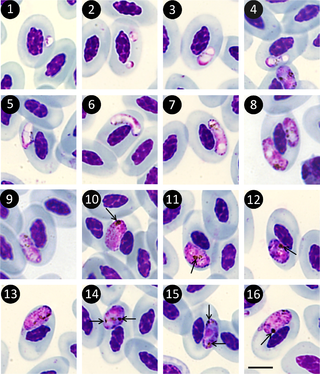
Plasmodium is a genus of unicellular eukaryotes that are obligate parasites of vertebrates and insects. The life cycles of Plasmodium species involve development in a blood-feeding insect host which then injects parasites into a vertebrate host during a blood meal. Parasites grow within a vertebrate body tissue before entering the bloodstream to infect red blood cells. The ensuing destruction of host red blood cells can result in malaria. During this infection, some parasites are picked up by a blood-feeding insect, continuing the life cycle.

The Plasmodiidae are a family of apicomplexan parasites, including the type genus Plasmodium, which is responsible for malaria. This family was erected in 1903 by Mesnil and is one of the four families in the order Haemospororida.
Giovanolaia is a subgenus of the genus Plasmodium created by Corradetti et al. in 1963. The parasites within this subgenus infect birds.
Novyella is a subgenus of the genus Plasmodium - all of which are parasites. The subgenus was created in 1963 by Corradetti et al. Species in this subgenus infect birds. It unites the avian malaria parasites with small erythrocytic meronts and elongated gametocytes.
Plasmodium dominicana is an extinct parasite of the genus Plasmodium.
Plasmodium bertii is a parasite of the genus Plasmodium subgenus Papernaia.
Dionisia is a genus of parasitic alveolates belonging to the phylum Apicomplexa.
Bioccala is a genus of parasitic alveolates belonging to the phylum Apicomplexa.
Plasmodium alaudae is a parasite of the genus Plasmodium.
Fallisia is a genus of the family Plasmodiidae.
Polychromophilus is a genus of obligate intracellular eukaryotic parasites that infect bats from every continent except Antarctica. They are transmitted by bat flies, which act as an insect vector as well as the parasite’s site of sporogeny. Polychromophilus follows a fairly typical Haemospororidian lifecycle, with gametocytes and gametes restricted to the bloodstream of the host and meronts infecting organs – most notably the lungs and the liver. The type species is Polychromophilus melanipherus, and was described by Dionisi in 1898.
Haemosporidiasina (Haemosporidia) is a subclass of apicomplexans described by Jacques Euzéby in 1988. The taxon is very similar to Aconoidasida.
Nycteria is a genus of protozoan parasites that belong to the phylum Apicomplexa. It is composed of vector-borne haemosporidian parasites that infect a wide range of mammals such as primates, rodents and bats. Its vertebrate hosts are bats. First described by Garnham and Heisch in 1953, Nycteria is mostly found in bat species where it feeds off the blood of their hosts and causes disease. Within the host, Nycteria develops into peculiar lobulated schizonts in parenchyma cells of the liver, similarly to the stages of Plasmodium falciparum in the liver. The vector of Nycteria has been hard to acquire and identify. Because of this, the life cycle of Nycteria still remains unknown and understudied. It has been suggested that this vector could be an arthropod other than a mosquito or the vector of most haemosporidian parasites.
Haemocystidium is a genus of parasitic alveolates belonging to the phylum Apicomplexia.
Garnia is a genus of parasitic alveolates belonging to the phylum Apicomplexia.
Achromatorida is an order of non-pigmented intraerythrocytic parasitic alveolates belonging to the subclass Haemosporidiasina. The order was created by Jacques Euzéby in 1988.

The Haemoproteidae are a family of parasitic alveolates in the phylum Apicomplexa.

Vetufebrus is an extinct genus of haemospororida in the family Plasmodiidae. At the time of its description the new genus comprised a single species Vetufebrus ovatus known from a single Miocene Dominican amber fossil found on Hispaniola. V. ovatus was vectored by Enischnomyia stegosoma, the first fossil streblid bat fly described from a fossil, and the only member of the subfamily Nycterophiliinae described from Hispaniola. V. ovatus is the first instance of a Streblidae bat fly as a host for a malarial parasite.
Irène Landau is a French parasitologist and professor emeritus at the National Museum of Natural History, France (MNHN) and Centre national de la recherche scientifique.




